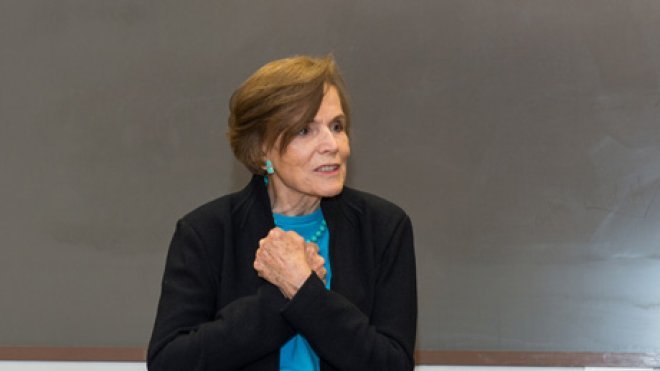Sylvia Earle: Ocean Life Makes Human Life Possible
Legendary oceanographer and marine scientist lauds RWU for marine
biology and aquaculture programs as a leading example of research and conservation efforts

BRISTOL, R.I. – Fish and chips made from the “catch of the day,” all-you-can-eat shrimp, Rhode Island’s beloved calamari – rarely do we question what actually comprises these fruits of the sea, or “seafood,” as it’s commonly called.
On Sept. 25, world-renowned marine scientist Sylvia Earle called for a reconsideration of seafood altogether, questioning social attitudes toward fish and shellfish as a commodity for consumption. Instead, she argued, these organisms ought to be considered wildlife, critical to the fragile fabric of the Earth’s ecosystem.
Consider this: Bluefin tuna takes nearly 20 years to mature and reproduce, but many are caught and sold as juveniles, compromising the repopulation and viability of the species. Or the squid caught for calamari, thus depriving marine life that relies on squid as a primary food source.
Earle – a legendary oceanographer and National Geographic explorer-in-residence – spent a full day at Roger Williams, kicking off the President’s Distinguished Speakers Series in celebration of 40 years of RWU’s marine biology program. Earle’s itinerary included a tour the Shellfish Hatchery, a master class with marine biology students, and a keynote address in which she urged students and a packed-room audience to stop believing that there is surplus marine life free for the taking – and that sustainable catch levels are a modern myth.
In the last 50 years, technological acumen has enabled us to kill over 90 percent of tuna, cod and certain sharks, Earle noted. When one species is fished out, we move on to the next. Even the North Atlantic Right Whale – so named because it was the “right” whale to hunt in whaling’s heyday – has stagnated at a few hundred individuals in the last decade.
“It’s not just the whales, it’s not just the tuna – it’s not just any one thing. It’s our power to consume the natural systems that, until right about now, seemed to be infinite in their capacity to recover, no matter what we took or if we just managed their numbers,” said Earle, the first female chief scientist of the U.S. National Oceanic and Atmospheric Administration and a pioneer in research on marine ecosystems who has led more than 100 expeditions totaling more than 7,000 hours underwater.
It wasn’t until she became an oceanographer and learned to recognize the unique attributes and personalities of sea life that Earle made a decision that would be anathema to most New Englanders: to stop eating seafood altogether. And while she defers from asking others to adopt her dietary choice, Earle does ask that seafood fanatics appreciate what they’re eating and the impact it will have on both the ocean ecosystem and the planet.
“Know what you’re doing and eat them with great respect, please – and don’t eat them all,” Earle said, pointing to the endangered sea turtles as an example. Once a popular menu item in the Gulf Coast region, it was only when residents became educated about the consequences of their actions that they became empowered to make a change. “Once you know, you start to care. You might know and not care. But you can’t care if you don’t know.”
As founder of Mission Blue Foundation, Earle has made it her life’s work to raise awareness of the challenges facing the Earth’s oceans and to enable swift and meaningful conservation programs. A community of more than 100 ocean conservation groups and supporting organizations, Mission Blue has lobbied to create 50 “Hope Spots” – internationally recognized marine protected areas (MPAs) that are critical to the health of the ocean. This month, the fate of these Hope Spots will be decided by the International Marine Protected Areas Congress, which has set a goal of creating MPAs in 10 percent of the oceans by 2020.
“It’s life in the ocean that makes our lives possible,” Earle said. “We’re just beginning to understand that without these creatures there’s no life.”
Put another way, she says, “No blue – no green.”
From the blue surface to the deepest and darkest depths, global waterways hold the most number of organisms in the world as well as the most biodiversity found anywhere. They are the most critical factor in determining the Earth’s climate, weather and temperature, Earle said, both removing carbon from the atmosphere and releasing more than half of the planet’s oxygen. Greenhouse gas emissions, pollution and overfishing are systematically destroying Earth’s greatest asset – and it’s not too big to fail, she assured.
“We have a planet in trouble,” Earle said. “This is a great era…of knowing, of access to information, of a means of finding answers to questions we never asked.”
Roger Williams University is helping to ask and answer, Earle said, particularly in the efforts of the aquaculture program that has created innovative programs for the cultivation and conservation of marine ornamentals, shellfish and oysters. Marine biology programs like RWU’s are critical, Earle emphasized, not just in producing fish and shellfish for consumption in an environmentally responsible way, but also in fostering a respect for the ocean and its influence on the planet.
Action shouldn’t be left in the hands of the few, however. Earle implored listeners that a collective effort is necessary to enact change that will preserve these waterways, the wildlife within them, and humanity. Life on Earth will continue, she said, with or without a human presence.
“It’s on our watch, on your watch,” Earle said. “Be so glad you were born now, if you care at all about making a difference for the future of humankind. Because the power we have now is magnified beyond anything that existed prior to the present time – because now we know what we could not know, could not see, until now.”